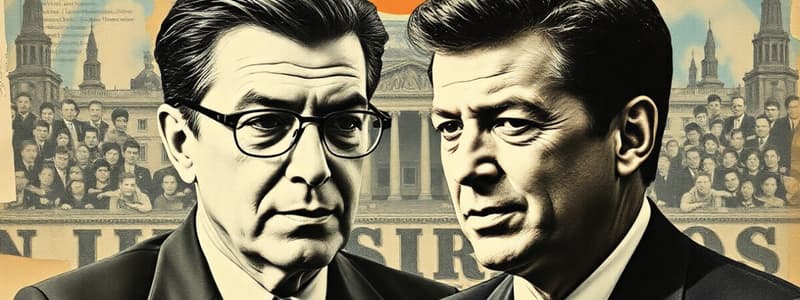Podcast
Questions and Answers
What was a key component of Reagan's economic policy?
What was a key component of Reagan's economic policy?
- Increasing government regulation
- Expanding social welfare programs
- Nationalizing major industries
- Tax reduction (correct)
What economic problem did Reagan aim to counter with his policies?
What economic problem did Reagan aim to counter with his policies?
- Deflation
- Hyperinflation
- Balanced budgets
- Stagflation (correct)
What was the name given to the 1981 bill that lowered tax brackets?
What was the name given to the 1981 bill that lowered tax brackets?
- The Economic Recovery Tax Act (correct)
- The Smoot-Hawley Tariff Act
- The Great Society Act
- The New Deal Act
What happened to unemployment rates during Reagan's presidency?
What happened to unemployment rates during Reagan's presidency?
By approximately how much did GDP grow per year during the Reagan administration?
By approximately how much did GDP grow per year during the Reagan administration?
What was the top income tax bracket percentage after the Tax Reform Act of 1986?
What was the top income tax bracket percentage after the Tax Reform Act of 1986?
What negative outcome was associated with Reaganomics?
What negative outcome was associated with Reaganomics?
What farming initiative did Reagan implement?
What farming initiative did Reagan implement?
What concept did Reaganomics refute?
What concept did Reaganomics refute?
Under Reaganomics, what happened to the gap between the wealthy and disadvantaged?
Under Reaganomics, what happened to the gap between the wealthy and disadvantaged?
Flashcards
Reaganomics
Reaganomics
Economic policies implemented by Ronald Reagan in the 1980s, focusing on tax cuts, deregulation, and reduced government spending.
Stagflation
Stagflation
A situation characterized by slow economic growth and high unemployment, accompanied by rising prices.
Supply-side economics
Supply-side economics
An economic policy that advocates reducing taxes and deregulating industries to stimulate economic growth.
Unemployment Rate
Unemployment Rate
Signup and view all the flashcards
Gross Domestic Product (GDP)
Gross Domestic Product (GDP)
Signup and view all the flashcards
Deregulation
Deregulation
Signup and view all the flashcards
Payment-in-Kind (PIK) Program
Payment-in-Kind (PIK) Program
Signup and view all the flashcards
Trickle-down economics
Trickle-down economics
Signup and view all the flashcards
Government Deficit
Government Deficit
Signup and view all the flashcards
Income Inequality
Income Inequality
Signup and view all the flashcards
Study Notes
Reaganomics Overview
- Reaganomics aimed to solve the economic issues of the 1970s, including oil crises, high-interest rates, and high unemployment, also known as "stagflation".
- It focused on countering these problems through tax reduction and deregulation.
- Critics labeled it "trickle-down economics" or "voodoo economics", asserting that deregulation and tax cuts harmed the poor.
- Supporters referred to it as "Reaganomics" or "free-market economics".
Key Policies and Actions
- Reagan deregulated multiple industries and lowered tax brackets through the Economic Recovery Tax Act after taking office in 1981.
- The Tax Reform Act of 1986 further simplified and reduced the tax structure under Reaganomics.
- These policies led to a mix of economic growth and wage increases, but also increased government debt and income inequality.
- Reagan also implemented the Payment-in-Kind (PIK) program in 1983 to address agricultural issues.
Economic Impact
- Oil access and pricing improved, shifting from scarcity and high prices to a glut due to increased supply and energy conservation.
- Unemployment initially rose to 11% in 1982 but decreased yearly to 5% by the end of Reagan's term in 1988.
- Interest rates fell from 10% to 4% during Reagan's administration.
- Gross Domestic Product (GDP) growth averaged 3.6% per year, a marked improvement from the 1970's average of 2.8 percent.
Tax Regulations
- The Economic Recovery Tax Act in 1981 decreased all tax bracket percentages and cut estate, corporate, and capital gains taxes.
- The highest tax bracket was reduced from 70% to 50% for the wealthiest taxpayers.
- The 1982 Tax Equity and Financial Responsibility Act partially reversed some tax reductions due to revenue loss.
- The 1986 Tax Reform Act further cut taxes per bracket, reducing the highest bracket from 50% to 28%.
Criticisms and Failures
- Income inequality increased significantly under Reaganomics, widening the gap between the rich and the poor.
- The Small Business Administration's business loan programs were cut by 32 percent.
- The federal deficit nearly doubled, with public debt increasing from 26% of GDP in 1980 to 41% in 1988.
- An estimated 3 million Americans fell into poverty during the Reagan years.
Impact on the Poor
- While Reagan reduced the "misery index", poverty programs experienced substantial cuts.
- Terms like "trickle-down economics" and remarks about the homeless led to perceptions that Reaganomics primarily benefited the rich and middle class but not the poor.
Impact on Farmers
- The Payment-in-Kind program (PIK) was implemented in 1983 to pay farmers for not growing crops, aiming to prevent crop surpluses.
- A drought in 1983 caused crop prices to rise, negatively affecting consumers and leading to farmers' dissatisfaction with PIK.
Significance
- Reaganomics, or supply-side economics, challenged Keynesian economics by reducing government control over markets.
- It aimed to boost the economy by reducing obstacles like taxes, allowing consumers to spend more.
- It resulted in an improved overall economy and standard of living for Americans in the 1980s compared to the 1970s.
- The success of Reaganomics in American economic history remains a topic of debate.
- Statistics indicate decreased unemployment and interest rates, along with an improved national condition.
Studying That Suits You
Use AI to generate personalized quizzes and flashcards to suit your learning preferences.




